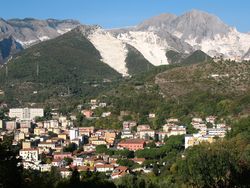Carrara
Carrara
Carara ( Emilian) | |
|---|---|
| Comune di Carrara | |
 | |
UTC+2 (CEST) | |
| Postal code | 54033 |
| Dialing code | 0585 |
| Patron saint | San Ceccardo |
| Saint day | June 16 |
Carrara (: "Fortitudo mea in rota" ("My strength is in the wheel"), a reference firstly to the marble shipping industry from Roman times onwards.
Toponymy
The word Carrara likely comes from the pre-Roman (Celtic or Ligurian) element kar (stone), through Latin carrariae meaning 'quarries'.[4]
History

There were known settlements in the area as early as the ninth century BC, when the Apuan Ligures lived in the region. The current town originated from the borough built to house workers in the marble quarries created by the Romans after their conquest of Liguria in the early second century BC. Carrara has been linked with the process of quarrying and carving marble since the Roman Age. Marble was exported from the nearby harbour of Luni at the mouth of the river Magra.[5]
In the early
After the death of
After the short Napoleonic rule of


At the end of the 19th century Carrara became the cradle of
In 1929, the municipalities of Carrara, Massa and Montignoso were merged in a single municipality, called Apuania. In 1945 the previous situation was restored.
Carrara is the birthplace of the
Title
As a titular
Economy
Carrara marble has been used since the time of Ancient Rome. The Pantheon and Trajan's Column in Rome are constructed of it, and many sculptures of the Renaissance were carved from it.
Culture
Fortitude Mea in Rota “My strength in the wheel”. The wheel of the carriage made to transport marble blocks from quarry to load out during Roman Empire and after, is the symbol of Carrara.
Coat of arms and symbols
According to the Grand Orient of Italy, the coat of arms of Carrara contains the Comacina wheel, symbol of the ancient master stonemasons of Como.[8][9][10]
Main sights
- Cathedral (Duomo, 12th century).
- Ducal Palace (also Palazzo Cybo Malaspina, 16th century), now the seat of the Fine Arts Academy. Built over pre-existing Lombard fortification, it dates to the reign of Guglielmo Malaspina, becoming in 1448 the permanent seat of the dynasty. It includes two distinct edifices: the Castello Malaspiniano, dating to the 13th century, and the Renaissance palace, begun by Alberico I in the late 16th century. Under the medieval loggia are exposed several ancient Roman findings.
- Baroque church and convent of San Francesco, built in 1623–64 by order of Carlo I Cybo-Malaspina.
- Church of the Suffragio, begun in 1686 under design of Innocenzo Bergamini, and refurbished in the 19th century. The façade has a large marble portal in Baroque style, sculpted by Carlo Finelli and surmounted by a bas-relief with the "Madonna and the Souls of the Purgatory".
- Palazzo Cybo-Malaspina
- Sanctuary of the Madonna delle Grazie alla Lugnola, consecrated in 1676 and designed by Alessandro Bergamini.
- Church of Santa Maria Assunta, at Torano. It has a 16th-century façade with a portal from 1554. The interior is on a nave and two aisles.





Sister cities
Carrara is
 Grasse, France
Grasse, France Ingolstadt, Germany
Ingolstadt, Germany Kragujevac, Serbia
Kragujevac, Serbia Opole, Poland
Opole, Poland Yerevan, Armenia
Yerevan, Armenia Yunfu, China
Yunfu, China
Notable people
- Eumone Baratta (1823~After 1890), sculptor
- Federico Bernardeschi (1994-), footballer
- Gianluigi Buffon (1978-), footballer
- Giorgio Chinaglia (1947-2012), footballer
- Hanna Eshel (1926-2023), sculptor
- Francesco Gabbani (1982-), singer
- Lorenzo Musetti (2002-), tennis player
- Pietro Tacca (1577-1640), sculptor
- Cristiano Zanetti (1977-), former footballer
- Carlo Bergamini (1868-1934), sculptor
See also
- No Cav
- Carrara marble
- Marmifera di Carrara railway
References
- ^ "Superficie di Comuni Province e Regioni italiane al 9 ottobre 2011". Italian National Institute of Statistics. Retrieved 16 March 2019.
- ^ "Popolazione Residente al 1° Gennaio 2018". Italian National Institute of Statistics. Retrieved 16 March 2019.
- ^ "Carrara and its precious white gold". www.mytravelintuscany.com. My Travel in Tuscany. 25 February 2017. Retrieved 25 February 2017.
- ^ Repetti
- ^ Carrara and its environs, InterScultura
- ISBN 978-3-8480-0321-1.
- ^ A Stronghold of Anarchists, The New York Times, January 19, 1894
- ^ "Stories of freemasons, republicans and carbonari / Il Tirreno Massa e Carrara". Archived from the original on 16 January 2021.
- ^ David Chiappuella (9 May 2014). "A new Masonic lodge will be born under the Apuane mountains". Archived from the original on 8 November 2023.
The same symbol of Carrara is the Comacina wheel, symbol of the masters of Como
- ^ David Chiappuella (15 November 2020). "Carrara, the Marmifera and the quarrymen seen from the eyes of Mary Poppins". Archived from the original on 8 November 2023.
- ^ "All'inaugurazione del CARMI presenti anche le delegazioni delle città gemellate con Carrara". web.comune.carrara.ms.it (in Italian). Carrara. 1 June 2018. Retrieved 13 December 2019.
- ^ "FESTIVAL - Yerevan Outdoor Advertising Festival". web.comune.carrara.ms.it (in Italian). Carrara. 26 October 2017. Retrieved 13 December 2019.
External links
- Official website
- Marble Quarry in the Massa and Carrara region
- "Carrara" (Marble), in The Monumental News Magazine, March 1893, pp. 273-275.
- "The Carrara Marble Industry," Scientific American Supplement, May 17, 1902, pp. 22045–22046.
- "A Marble World" (Carrara, Italy), by E. St. John Hart, article in Pearson's Magazine, February 1903
- Landsat 7 photograph of Carrara marble quarries in August 2001
- Overnight in Carrara, Italy - slideshow by The New York Times



